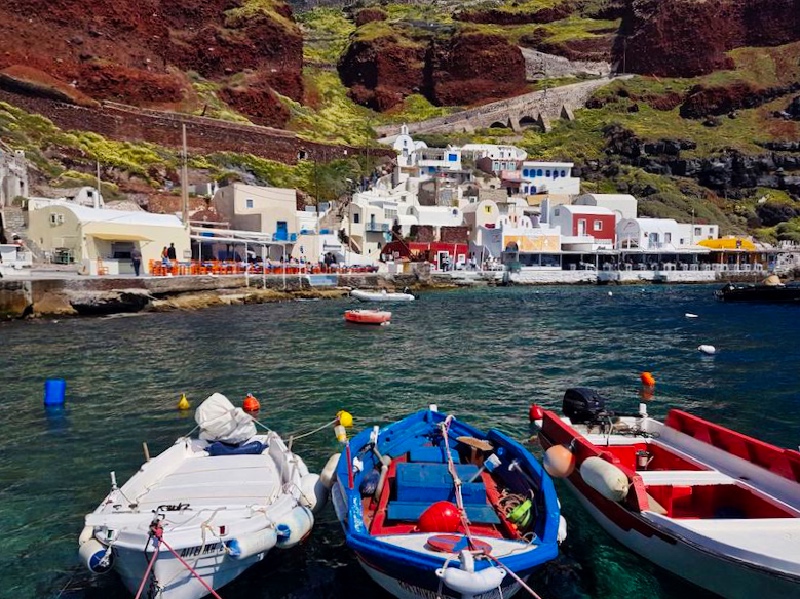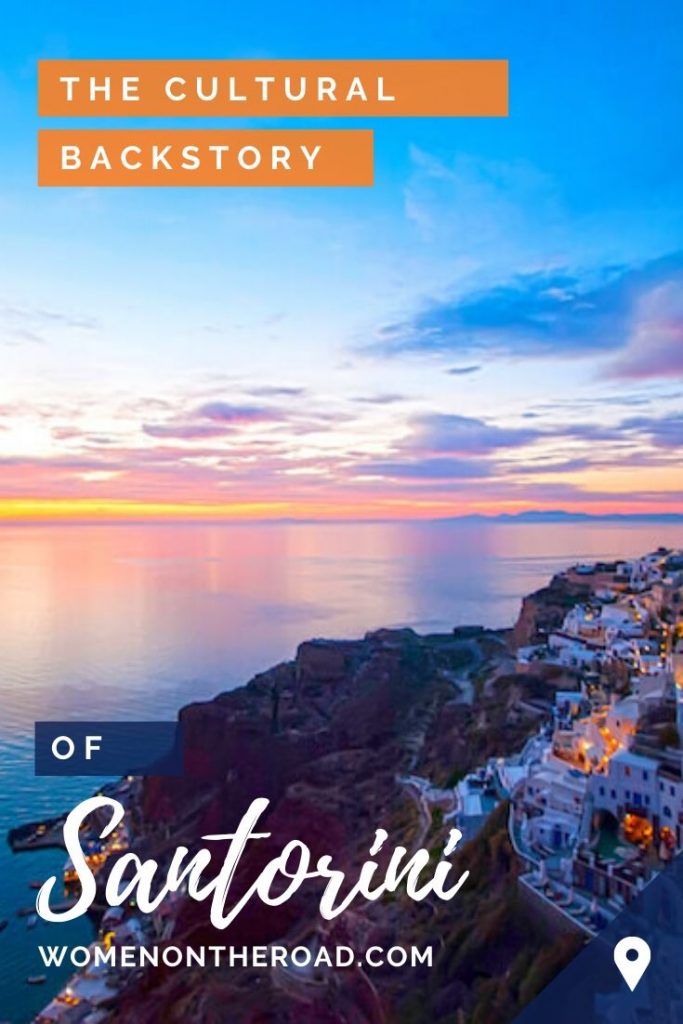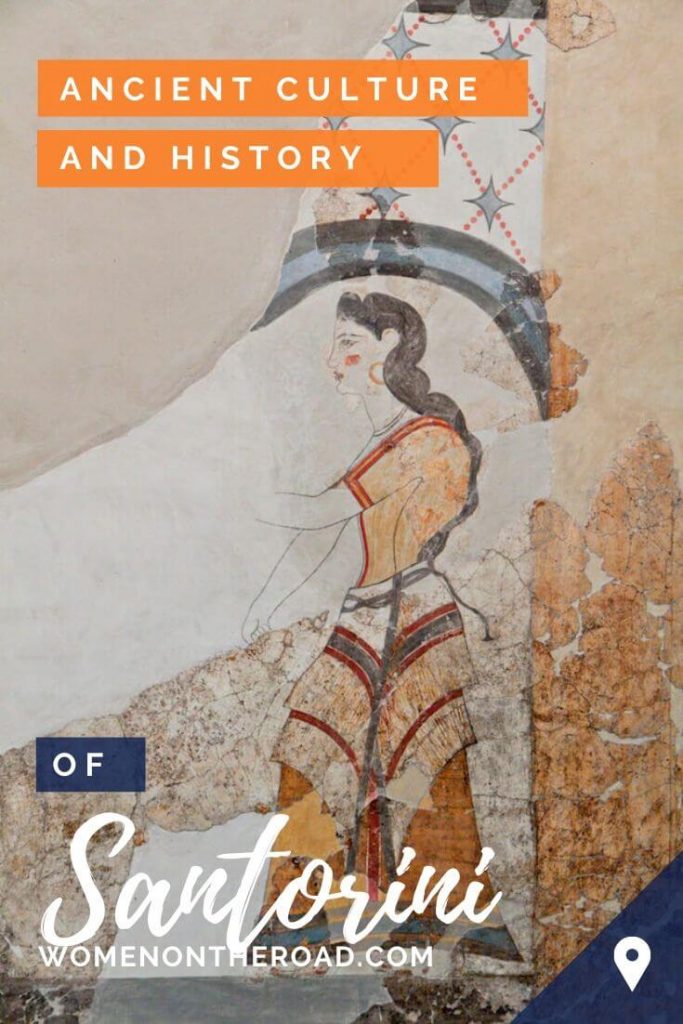Many historians will tell you that to understand the present, you need to understand the past: nowhere is this truer than on Santorini.
Although at first it might seem like an ultra-glamorous playground, Santorini is also a history and culture buff’s paradise, with layer upon layer of history stretching back more than 3600 years.

Despite these many years of history, Santorini’s delicate balance is at risk.
The island’s fragile ecosystem is threatened by overtourism: in 2019, between 1.5-1.8 million tourists visited this tiny island, which is only 18 kilometers (11mi) long and 1.8 kilometers (1.1mi) wide, most of them between June and September.
If these numbers continue to rise, local ways of life will be entirely replaced by the tourism service industry.
This doesn’t mean you shouldn’t visit Santorini, not at all. Just come off-season and explore an incredibly rich maritime and geological history. This will help support locals who try to make a living all year round, especially those who grow produce.
And traveling from Athens to Santorini is really quite simple!
A closer look at Santorini’s history
Several of the world’s great empires and kingdoms have laid claim to Santorini and shaped its culture and aesthetics. From the Minoans − the romantic lost Bronze Age civilization, once the most advanced in Europe − to the Ottomans, peeling back the layers of Santorini’s history adds depth to any curious traveler’s Aegean adventures.

Through this article, we’ll trace the history of Santorini and explain how this history has shaped the culture and architecture that is prominent on the island today. Knowing the dramatic and romantic backstory of Santorini, you’ll never look at the island the same way again.
The history of Santorini
Casting your eyes over the glamorous and developed island of Santorini, it’s hard to picture its beginnings as a humble fishing village. However, this is what the earliest archaeological evidence reveals.
The earliest inhabitants
Items from around 4500 BC show that by this time, Santorini was home to a Neolithic settlement whose heartland was the southern tip of the island. Many tourists don’t explore the southern part of Santorini as it is the furthest from the caldera-edge village and towns. But this was the birthplace of Santorini culture.
While the Neolithic settlement (the Neolithic era was the start of human agriculture) was a humble start for Santorini, the island benefitted enormously from its location in the middle of the trade route between the Mediterranean islands of Cyprus and Crete. Progress was slow but definite and by around 3000 BC, the village of Akrotiri had grown into a bustling city.
Strongyli: Ancient Akrotiri and the Minoans in the Bronze Age
By the end of the third millennium BC, what we now call ‘Ancient Akrotiri’ (as opposed to the lovely modern-day fishing village of Akrotiri right next to it) was an advanced Minoan settlement. The Minoans are considered Europe’s first advanced civilization and are most closely associated with the nearby island of Crete.
Although the Minoans are perhaps best known for living on Crete, Santorini’s Akrotiri was also important to them. By 1700 BC, Akrotiri was at its zenith and offered all the conveniences of a proper city: hot and cold running water, beautifully decorated frescoes and multi-story buildings with stylish staircases and large windows.
A sophisticated city-wide sewerage system allowed for toilets in these sophisticated homes and it has even been suggested that these early Santorini residents had underfloor heating. On a clear day, wealthy residents of Ancient Akrotiri could catch a glimpse of Crete across the water from their terrace above their three-storied villas.
There’s no doubt the Minoans of Akrotiri were wealthy, and not just from the riches of the saffron trade they were known for. They also had a strong, artistic culture, along with deep spirituality. Most famously, Minoans worshipped goddesses, leading some historians to believe it was a matriarchal society.
My favorite fresco uncovered in Ancient Akrotiri shows confident and beautiful young women weaving, at ease with their own company. It is rare to find images from the deep past of human history that show young women happy and carefree. Archaeologists have also found intricate hair clips, so we know that both young men and women in this refined society were fashion conscious.
It was a good time to live on Santorini.
The Theran eruption

Unfortunately, like in so many ancient cities, the good times did not last.
Around 1550 BC (as suggested by new radiocarbon dating and ancient Egyptian written records), Akrotiri would go out with a bang.
This was, of course, the Theran eruption, which saw Santorini’s massive volcano explode with lava and ash, forever altering the course of civilization on the Greek Islands.
It is difficult to overstate the power and devastation of this eruption. It is believed to have affected everything within a 100-kilometer (62mi) radius, most notably by eradicating the powerful Minoan civilizations of Crete and Santorini.
It also forever shaped the face of Santorini, as Strongyli, as the original island was called, was ripped into separate islands. It was − and is − considered the most significant environmental event in human history, with sediment from Santorini found in lakes in Turkey.
After the explosion, Santorini (the remaining part of the Strongyli), lay abandoned for centuries.
Interestingly, excavations at the famous archaeological site of Ancient Akrotiri have not unearthed any human casualties from the eruption, suggesting there was enough time for an orderly escape by sea.
Lava flowed through the deserted streets of Akrotiri, preserving the town perfectly as a relic of the past.
Today, it is astonishing to wander through the preserved streets, marveling at the ancient architecture. Many of the beautifully colored frescoes are preserved in Greek museums, revealing the talent of Minoan artists.
Akrotiri: the Lost City of Atlantis?
If you feel that the story of Akrotiri’s rise, fall and later unearthing seems plucked from the pages of a book or novel, you’re not alone. Many believe that it was this story that directly inspired Plato’s Atlantis.
Considering the sophistication of Minoan civilization, the shape of Santorini and its spectacular and sudden destruction, the theory has at least as much merit as the many fanciful locations for the reputed lost city.
Thera and several turbulent centuries
No one knows where the former residents of Akrotiri went, but they were never to return to the island. It remained uninhabited for several centuries until the Phoenicians arrived and named it Callista, a name drawn from the Phoenician phrase for most beautiful. Anyone who has visited Santorini will surely agree this is apt.
This ushered in a period where Santorini − or Thera, as the incoming settlers had named it − changed hands several times.
As happened often with Greek territories, Santorini found itself in the hands of the Romans but once Rome fell, the island became part of the Byzantine Empire.
Around 727 AD, Santorini was again shaped by a large volcanic eruption. The ruler at the time declared this was due to islanders’ worship of religious icons, and the icons were swiftly banned.
This is also when the earliest mentions of ‘Santorini’ are recorded. The name is believed to stem from Saint Irene, the island’s patron saint. It is unknown exactly how or why this became the best-known moniker for the island – but it certainly has a ring to it.
Around the time Santorini was catching on, the beautiful church of Panagia Episkopi was built, complete with many of the icons which had previously been banned. Panagia refers to the Virgin Mary. Despite Santorini’s tumultuous history, the church has survived and thrived and remains an important spiritual and tourist site to this day.

The Venetians arrive… with wine

The Byzantines would remain in control of Santorini for nearly half a millennium until the fall of Constantinople (modern-day Istanbul) to the Crusaders in 1204 AD. It then passed into the hands of the Republic of Venice.
The Venetians quickly realized the uniquely dry and volcanic soil of Santorini was perfect for vineyards. They were soon exporting Santorini wine, including the indigenous assyrtiko grape, throughout the world; the grape is credited with helping grease the wheels of many political conversations during this time.
Santorini wine remains, to this day, revered worldwide.
As well as introducing the world to Santorini wine, the Venetians greatly shaped modern-day Santorini with their architecture. They built many structures, including the “impenetrable” Venetian fortress still on display.

Santorini: modern history and culture
Ironically, the “impenetrable” Venetian fortress was eventually taken by the Ottoman Turks, after centuries of skirmishes between the two, which continued right up until the 1700s. Ottoman architecture, too, is on display on Santorini, and the island is truly an open-air museum, with exhibits from many of the world’s most powerful empires.

While the Ottoman Turks were predominantly Muslim, Santorini locals did not adopt their faith. The Turks continued exporting Santorini wine despite their religious aversions to the trade − that’s how important it was to the island’s economy and culture.
The next major change for Santorini was brought about by the Greek War of Independence in 1821. After more than a decade of fighting, Santorini became part of the Kingdom of Greece, and it remains Greek to this day (barring brief periods of Italian and German occupation during World War II).
The famous architecture of Santorini
For much of its history, including the 19th and 20th centuries, Santorini was an important maritime hub.

As such, many people worked hard and in low-paid jobs fishing, sailing and maintaining the boats and ships on the island. These working-class mariners struggled to afford the more expensive hilltop houses and land on Santorini, where the wealthy and powerful lived.
If you wander along the Oia clifftop path, you will pass by the three-story homes of the ship captains who once controlled Santorini’s maritime fleet.
But the less fortunate seafarers came up with their own ingenious idea, one that would shape the face of Santorini forever: they built houses into the cliff-face, resulting in the island’s famous cave homes.
These houses were far from glamorous, with generally a single room and a carved-out oven area. But they were extremely practical. The Theraic earth of Santorini is an excellent building material, providing insulation as well as some resistance from natural disasters.
Perhaps even more famous than the cave houses of Santorini are the iconic whitewashed, curved stone villas with their blue domes and doors, now known as the Cycladic architectural style.
As with the cave houses, buildings developed around the environment. Not only are the white homes strikingly beautiful, but they’re also practical: they reflect the intense heat of the island and help keep interiors cool.
Some historians also believe that whitewash was chosen because it was a cheap and readily available disinfectant, an important factor at a time when the Greek Isles were ravaged by diseases such as cholera. There were periods when the Greek government mandated the white and blue color scheme but later, locals saw the colors attracted tourists so the blue and white was maintained after Greek military rule ended.
And so the history and architecture of Santorini unfold in fascinating chapters, allowing us to look at those glamorous white villas in a new way.
Santorini’s culture today

As you can see, Santorini has a fascinating and varied history, one that has been influenced by its geography, including its volatile terrain and its strategic position on the Aegean Sea.
The cycles of birth and death that resulted from earthquakes and volcanic eruptions have shaped the geography and the built environment.
Villages have been deserted, homes have been built deep into the cliffs of the island, and a seasonal economy based upon trade with the mainland and other Cycladic islands have combined to create the Santorini you see today.
These geological events and cycles have influenced the culture of Santorini, which has drawn elements from many of the world’s great trading and invading civilizations, as well as developing its own.
Although Santorini has modernized in many ways, you’ll also get plenty of glimpses of the Santorini of old. These traditions are especially common during celebrations and on special occasions. For example, many people on Santorini will celebrate their ‘name day’, which is like a birthday but celebrated instead on your Saint’s day. Likewise, weddings are a festive affair filled with ancient traditions, such as the bride’s father shouting from the rooftops that the wedding has begun.
Yet another joyful occasion filled with rituals is the building of a new house in the many small villages of Santorini. Raki, a local liqueur, and honey are usually prepared for the builders of the home, while coins are thrown into the foundations for good luck. While these are almost impossible to spot, if you look closely you will also see a small cross – yet another good luck charm to protect the home and its future occupants.
There are five moments in Santorini’s annual calendar of religious and cultural events where you can most clearly see evolving traditions.
- Ephestia, or “Volcania”: several days of festivities in August that culminate in a fireworks display that mimics the eruption of the volcano.
- 20 July, the feast day of Profit Elias
- 4 August, in the village of Oia, the day of Ayioi Epta Paides
- 15 August, in the village of Messa Gonia, the religious celebration of Episkopi
- 22 October, the day on which wine was traditionally harvested on Santorini. It is the feast day of Saint Averkios, the patron saint of wine. Followed by a church service, there’s a Bacchanalian wine feast and it is a great day to visit Santorini’s wineries!
There’s no doubt that Santorini’s beauty catapults it to the top of many travel wish lists and for one excellent reason: it is perhaps the most beautiful and beguiling island you will ever visit.
However, there is so much more to this incredible island, and exploring Santorini’s history and culture will only add depth and context to your visit to this most enchanting Greek island.
Top 8 things to do in Santorini
Put all that history and culture to work as you visit the island and sample the ten best things to see on Santorini.

1. Watch the sunset over the caldera. It is one of the most magnificent sunsets in the world. It’s free, sustainable, carbon-neutral and breathtakingly beautiful.
2. The Fira to Oia Hike is possibly – and this is a big call – the most beautiful walk you will ever take.
3. If you’re wondering about where to stay in Santorini for first timers, it is most definitely the glorious village of Oia. Try a cave house with a small private pool, something like this one.
4. Take a Santorini sailing cruise around the caldera.
5. Visit Ancient Akrotiri and the Museum of Prehistoric Thera in Fira and see this astounding archaeological site and its frescoes.
6. Wine tasting in Santorini’s wonderful wineries – you can even watch the sunset over the caldera from two of them.
7. Walk the winding stone laneways of Santorini’s historic villages such as Pyrgos, Megalochori and Emporio. See everyday life and culture away from the caldera’s edge.
8. Eat seafood in a taverna on the water at Ammoudi Bay or Akrotiri village.
Guest Contribution by Monique Skidmore. Monique is an award-winning cultural anthropologist and a prize-winning writer who blogs at Trip Anthropologist. An Australian and a long-time expert on Myanmar, Monique writes about the culture, history and scenic beauty of some of the world’s most fascinating and iconic destinations.
SHOP THIS POST ON AMAZON
PIN THESE PICTURES AND SAVE FOR LATER!







